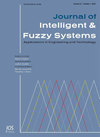The purpose of the Journal of Intelligent and Fuzzy Systems: Applications in engineering and Technology is to foster the exchange and dissemination of applications and case studies in the areas of fuzzy logic, intelligent systems, and web-based applications among working professionals and professionals in education and research, among a broad cross-section of technical disciplines. It is the intent of the journal to expedite to the maximum extent possible, given the overall constraints of quality and currency, the dissemination of practical applications of the various theories and methods developed in the fields of intelligent systems, fuzzy systems and web-based applications. The journal will serve its audience by publishing both archival articles and broader assessments of current trends. Articles will be subject to anonymous peer review. The journal will publish original articles on current and potential applications, case studies, and education in intelligent systems, fuzzy systems, and web-based systems for engineering and other technical fields in science and technology. The journal has broad interest in the disciplines of computer science, electrical engineering, manufacturing engineering, industrial engineering, chemical engineering, mechanical engineering, civil engineering, engineering management, bioengineering, and biomedical engineering. The scope of the journal also includes developing technologies in mathematics, operations research, technology management, the hard and soft sciences, and technical legal and environmental issues. A new thrust of the journal is in web-based technologies. As computers have proliferated into consumer products, web-based appliances are swiftly coming into existence. This signals the start of a new discipline for ubiquitous or pervasive computing where local intelligence creates a global consciousness. We solicit papers on the architecture, implementation and realization aspects of creating intelligent functions over a network. Networks have become geographically distributed, highly interactive and seemingly chaotic. Such networks do not necessarily have to be large on an absolute scale, but can also be small using micro-controllers on a tiny area like a home. What remains is the glue by the web. The web provides a medium of interaction that allows intelligence to be shared, leading to functions that integrate over available appliances. This new field ranges from embedded intelligence on small controllers to grid-scale self-healing networks of larger processors. Topics might include discussions on how intelligence is instilled on a single node by embedded software or dedicated hardware, how intelligence is created from the co-operation of some nodes by a formally proven system architecture and how intelligence is enriched over the communication between the parts by agent technolo
